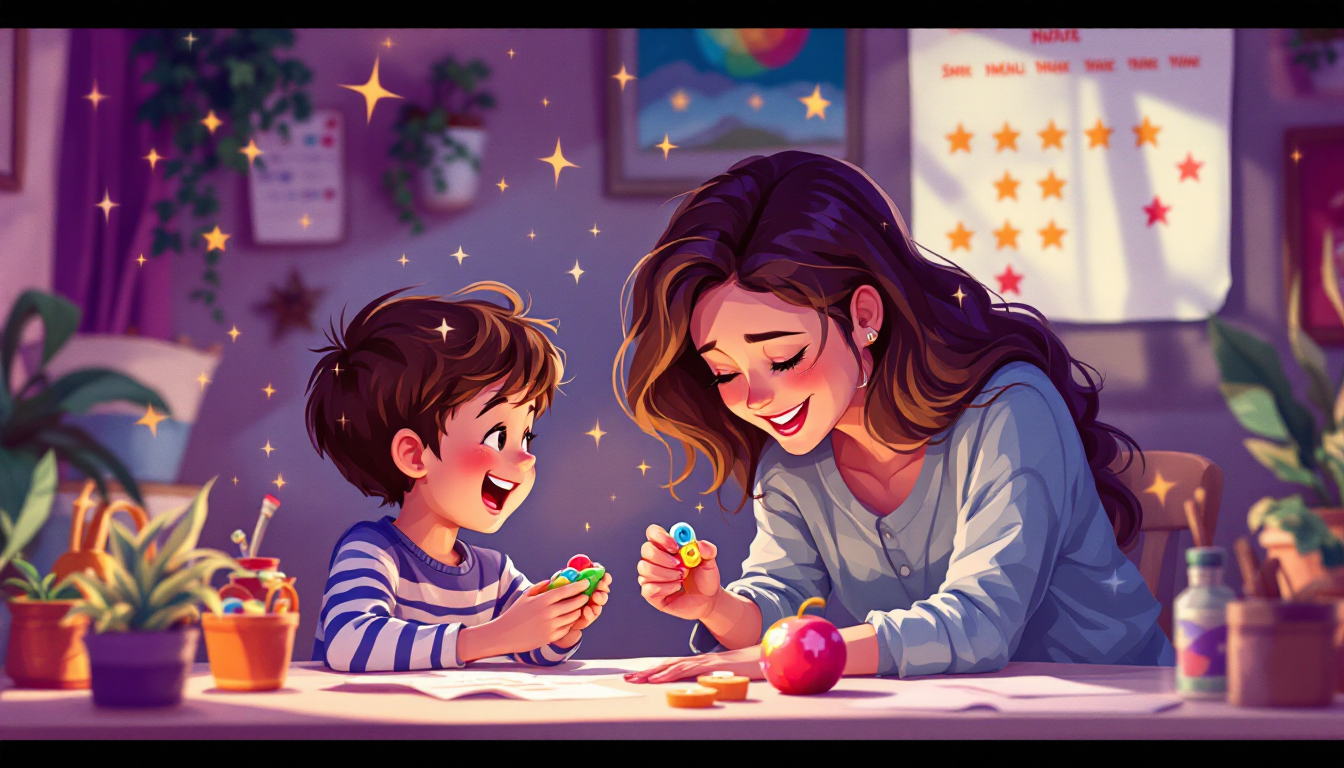How to Teach Kids with ADHD to Self-Soothe in High-Stress Moments

As a parent of a child with ADHD, you know that high-stress moments can feel like an emotional storm, with meltdowns hitting without warning. You've likely tried everything—logic, timeouts, pleading—only to find that nothing seems to work. The intense emotional dysregulation that comes with ADHD can make simple transitions or unexpected changes feel like a catastrophe for your child, leaving both of you feeling overwhelmed and exhausted. If you're looking for practical, effective strategies on how to teach kids with ADHD to self-soothe in high-stress moments, you've come to the right place. This article will guide you through the "why" behind these big emotions and provide you with a toolkit of proven strategies, from sensory tools to visual aids, that can help your child build the skills they need to navigate their emotional world with more confidence.
What Makes Self-Soothing Difficult for ADHD Kids?
It's easy to assume a child is "just being difficult," but for a child with ADHD, emotional impulsivity is a core feature of their neurobiology. The brain's executive function, responsible for impulse control, planning, and emotional regulation, is often underdeveloped or operates differently. This means that a minor frustration, like a lost toy or a change in plans, can quickly escalate into a full-blown meltdown because their brain struggles to hit the brakes on a big emotion.
This isn't a behavior problem; it's a neurological one. Traditional calming strategies, like telling a child to "calm down" or "use your words," often fail because the part of the brain that processes these logical commands is offline during a moment of intense emotional dysregulation. This is why ADHD emotional regulation requires a different approach, one that works with their brain, not against it.
How to Lay the Foundation for Self-Soothing
Before you can expect your child to self-soothe independently, you need to build the foundational skills when they are calm. This process is about building a toolkit and a vocabulary for their feelings.
Building Emotional Vocabulary
You can’t manage a feeling you can’t name. Help your child expand their emotional vocabulary beyond "mad" and "sad." Use a feelings chart or flashcards with different facial expressions and emotions. When you notice a feeling in them or yourself, label it: "You seem frustrated that the puzzle piece isn't fitting," or "I'm feeling a little overwhelmed by all this noise." This practice helps them connect the physical sensations in their body to a specific emotion, which is the first step toward managing it.
Creating a Calm-Down Corner or Toolkit
A designated "calm-down corner" provides a safe, predictable space for your child to retreat to when they feel big emotions bubbling up. Work with your child to fill a box or a basket with a collection of self-soothing tools. This toolkit could include:
-
Sensory objects: A squishy ball, a fidget spinner, a soft blanket, or a weighted lap pad.
-
Creative outlets: Paper and crayons, a sensory bottle with glitter, or play-doh.
-
Calming sounds: A small speaker for calming music or a rain sounds machine.
-
Visual aids: A feelings chart, a calming visual timer, or a "how to calm down" poster with pictures.
This space is not a punishment area; it's a place of regulation and restoration.
The Role of Co-Regulation Before Independence

Co-regulation is the process of a caregiver helping a child regulate their emotions. Before a child can self-soothe, they need to be soothed by a trusted adult. When your child is in the throes of an ADHD meltdown, your calm presence is the most powerful tool you have. Instead of talking, try these co-regulation techniques:
-
Offer a calm, firm hug or a gentle hand on their back. Deep pressure can be incredibly grounding.
-
Model slow, deep breathing. Don't tell them to breathe; just do it yourself.
-
Narrate what you are doing in a low, soothing voice: "I'm here with you. We're safe. We can sit here until your body feels a little calmer."
This external regulation is what builds the neural pathways for internal regulation.
Proven Self-Soothing Strategies That Actually Work
Once the foundation is set, you can introduce specific calming strategies for ADHD that your child can eventually use on their own.
Deep Pressure Tools: The Power of a Hug
Many neurodivergent children find deep pressure incredibly soothing. It provides proprioceptive input, which helps their brain and body feel more organized and calm.
-
Weighted blankets and lap pads: These can be used in the calm-down corner or even at the dinner table to provide a sense of groundedness.
-
Therapeutic hugs: A firm, full-body hug can be a game-changer. Teach your child to ask for a "bear hug" when they feel overwhelmed.
Compression clothing: Snug-fitting clothes can provide a constant source of soothing pressure throughout the day.
Grounding Techniques: The 5-4-3-2-1 Method
Grounding techniques bring the child's attention back to the present moment and their physical surroundings, pulling them out of a chaotic internal state. The 5-4-3-2-1 method is a simple sensory exercise:
-
5: Name five things you can see.
-
4: Name four things you can feel.
-
3: Name three things you can hear.
-
2: Name two things you can smell.
-
1: Name one thing you can taste.
Practice this technique with them during calm times, so it becomes a familiar tool for high-stress moments.
Breathwork and Visual Timers
Teaching a child with ADHD to "just breathe" can be a challenge. Visual aids make it tangible.
-
Use a pinwheel: Have them blow on a pinwheel to practice deep, steady breaths.
-
"Belly breathing" with a stuffed animal: Have them lie down and place a stuffed animal on their belly. As they breathe in and out, the stuffed animal goes up and down. This visual feedback helps them understand the concept.
-
Visual timers: Use a sand timer or a bubble timer to help them practice a specific breathing exercise for a set amount of time. This provides a clear start and end point, which is crucial for children with ADHD.
Roleplay and Social Stories
Practice makes perfect. Use roleplay to act out common scenarios that trigger meltdowns. For example, role-play a situation where a friend takes their toy. In the roleplay, practice using a calm-down strategy like taking three deep breaths. Social stories are short, simple narratives that describe a specific social situation and the appropriate response. For example, a story could be titled "When I Feel Frustrated at the Store" and include pictures of the calming strategies they can use.
When and How to Teach These Skills
The most critical rule of teaching self-soothing is to teach it when your child is calm and regulated. Trying to teach a new skill during a meltdown is like trying to build a house in a hurricane.
-
Practice during calm moments: Make it a fun, daily ritual. "Let's practice our belly breathing for one minute!"
-
Use positive reinforcement and progress tracking: Celebrate the small wins! Use a sticker chart or a reward system to track their practice. When they successfully use a strategy, praise their effort, not the outcome. "I saw you take a deep breath when you got frustrated, that was so strong!"
-
Parental modeling: Children are always watching. Model your own neurodivergent parenting tips in action. When you feel stressed, say out loud, "I'm feeling a bit overwhelmed right now, I'm going to go take a few deep breaths." This shows them that it's normal to have big feelings and that there are healthy ways to manage them.
Common Mistakes to Avoid

Forcing Calm When Dysregulated
The phrase "calm down" is often a trigger. When a child is dysregulated, their nervous system is in a state of fight-or-flight. They need connection and co-regulation, not demands. Instead of "Calm down," try "I'm here with you" or "Let's find a cozy spot."
Ignoring Sensory Sensitivities
A child's meltdown might be triggered by an overwhelming sensory input, such as a loud noise, a scratchy tag on their shirt, or the smell of dinner cooking. Pay attention to the triggers. By proactively managing their sensory environment, you can prevent many high-stress moments from even happening.
Overloading Kids with Verbal Instructions
During a meltdown, a child's auditory processing is often compromised. A barrage of words will only escalate their frustration. Use short, simple phrases, and rely on visual cues or physical prompts instead.
Conclusion: Celebrating Small Wins

Teaching your child how to teach kids with ADHD to self-soothe in high-stress moments is a marathon, not a sprint. There will be days of progress and days of setbacks. Celebrate every small win, whether it's one deep breath instead of ten minutes of crying or a request for a "bear hug" instead of yelling. Each moment is a building block in their journey toward emotional regulation. Remember that self-soothing is a learned skill that takes time, practice, and a whole lot of patience and empathy from you. Continue to build their toolkit, practice together, and trust in the process. Your unwavering support is the most powerful tool of all.
Download the Bonding Health App today and start your journey with guided calm-down activities designed specifically for neurodivergent children and their parents.


